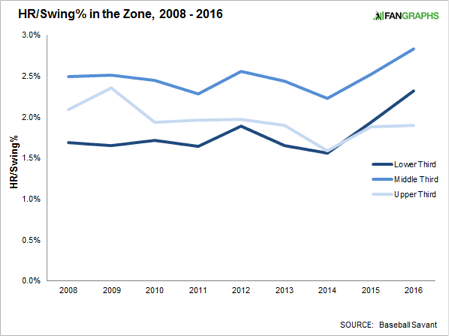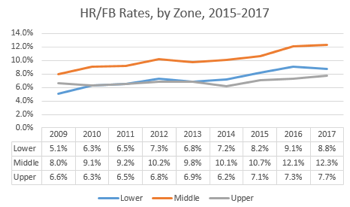This article is part of our Collette Calls series.
Much has been made of batters looking to launch with changes to launch angle with Yonder Alonso the latest face of the movement. The league's fly ball percentage has bone up from 33.8 to 34.6 percent to its current rate of 35.5 percent. As I began working on this piece around a very busy professional schedule, FanGraphs' Travis Sawchik wrote an article that looked at non-juiced ball reasons for why homers are surging. Within that article are many reasons that have been bantered about and none are any more conclusive than the other. The ball does not appear to be juiced, the strike zone is shrinking, but is has only been a year, and the distribution of homers between the best hitters in the league and the normalized rate is well in line with other years that exclude the steroid era.
One of the many beautiful things about baseball is that is it anything but constant. Thirty-five years ago, Billy Martin
Much has been made of batters looking to launch with changes to launch angle with Yonder Alonso the latest face of the movement. The league's fly ball percentage has bone up from 33.8 to 34.6 percent to its current rate of 35.5 percent. As I began working on this piece around a very busy professional schedule, FanGraphs' Travis Sawchik wrote an article that looked at non-juiced ball reasons for why homers are surging. Within that article are many reasons that have been bantered about and none are any more conclusive than the other. The ball does not appear to be juiced, the strike zone is shrinking, but is has only been a year, and the distribution of homers between the best hitters in the league and the normalized rate is well in line with other years that exclude the steroid era.
One of the many beautiful things about baseball is that is it anything but constant. Thirty-five years ago, Billy Martin let Alfredo Griffin attempt 41 steals even if he only converted 18 successfully. Today, a manager could be dismissed for allowing that type of lunacy. We have not seen a National League pitcher with a double-digit complete game total in the 21st century as Randy Johnson last did it in 1999, and James Shields is the only pitcher since to do it. Flash back to 1987, and Roger Clemens completed 18 games. I bring these things up because every time one part of the game does something, another part reacts. Managers decided to counteract the stolen base by emphasizing the slide step, foot work and pop times. They counteracted complete games by working counts trying to work walks and spoiling pitches instead of putting the first good pitch into play and hoping for the best.
What I am interested in is what pitchers will do to counteract the recent power surge by batters. Jeff Sullivan of FanGraphs broached a method in March on the heels of an interview Sawchik did with J.D. Martinez. Martinez claimed he was already seeing pitchers trying to combat his hitting philosophy of trying to hit the ball in the air with every single swing:
While Martinez believes there is being progress made league wide, he already sees pitchers trying to combat his hitting philosophy. "Pitchers are countering it right now. The pitchers are always ahead," Martinez said.The common thought to combating home runs is to keep the ball down in the zone because pitches down there generate more groundballs. In theory, and in research, that is a factual statement. Yet, I don't think so, Tim. One of the things Sullivan picked up on in his research is that home run rates were mostly stable from 2008-2014 in all three thirds of the strike zone, but that has changed in recent years. The recent home run surge is not coming from pitches up in the zone; rather, it is from pitches in the lower and middle third of the zone.

Pitchers got the head start in the post-steroid era by throwing more pitches in the lower part of the zone. Despite the fact we have seen a surge in homers per swing in the bottom third of the strike zone, pitchers are not changing their plans as the percentage of pitches in that location is higher than it has ever been since such data has been trackable:

Perhaps we are seeing a continuance of the home run surge because pitchers are, in fact, not ahead of the batters here. Despite the fact home runs per swing are up in the bottom third of the zone, the league is continuing to fill the bottom of the zone in search of the ground ball. The fact that home run rates in the middle third are also up highlight the fact that when a pitcher misses, they tend to miss up so missing the spot low in the zone moves them from one zone on the rise to another one.
The table below shows some of the metrics on pitches from 2015-2017 in each of the three zones:
| ZONE | AVG | SLG | HR% | HR/FB | BABIP |
| Lower Third | .231 | .351 | 2.0% | 8.7% | .304 |
| Middle Third | .296 | .497 | 4.1% | 11.5% | .305 |
| Upper Third | .218 | .366 | 2.6% | 7.3% | .272 |
If pitchers want to limit batting average and balls in play, they are better off pitching up in the zone. While the rate of homers is higher on pitches in the upper third, the home run per flyball is lower than it is in any other part of the zone.

There are exceptions to this as Dallas Keuchel, Zack Greinke and Jon Lester are doing just fine filling the lower third of the zone night in and night out but we are also talking about some of the elite pitchers in the game. We also have 16 pitchers who have yet to allow a home run on a pitch in the lower third of the zone (min 50 batters faced):
| PITCHER | BF | HR |
| Mike Leake | 111 | 0 |
| Chris Archer | 99 | 0 |
| Ervin Santana | 96 | 0 |
| Danny Duffy | 84 | 0 |
| Chris Sale | 83 | 0 |
| Jason Vargas | 80 | 0 |
| Amir Garrett | 80 | 0 |
| Yovani Gallardo | 77 | 0 |
| Matt Andriese | 77 | 0 |
| James Paxton | 74 | 0 |
| Stephen Strasburg | 71 | 0 |
| Derek Holland | 66 | 0 |
| Chase Anderson | 64 | 0 |
| Justin Verlander | 56 | 0 |
| Hector Santiago | 53 | 0 |
| Jimmy Nelson | 53 | 0 |
That is quite the range of talent on that list. There are studs and pre-season duds on that list. There are pitchers with big fastballs and dancing stuff that make it tough on batters wherever they locate. There are also pitchers like Andriese, Anderson, Holland and Vargas have similar approaches to the game where they work up with the fastball and down with the changeup to change eye levels and do their best to stay out of the zone. Please do not ask me to explain the deal with the devil Santana has made with his .128 BABIP and 98 percent LOB rate as it is not possible to do, nor sustain.
If the pitchers are indeed ahead of the batters, the reason is not abundantly clear. We have been taught to chase pitchers that keep the ball down in the zone, but perhaps we should revisit that maxim and not avoid pitchers that work up in the zone. Pitches up there are put into play less frequently than others because they can become harmless pop-ups and flyballs have the lowest chance to become base hits. You don't need big velocity to work up there as Koji Uehara has made a career of pitching up there with below-average velocity while pitchers such as Andriese and Jeremy Hellickson are doing well this year. While we continue to work to uncover how the pitchers are trying to stay ahead of the hitters, let's not eschew the pitchers that are getting it done in the short term.










